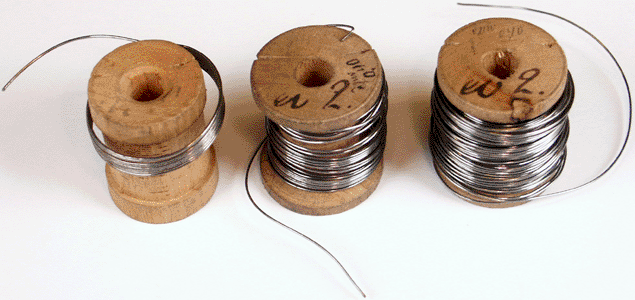D R A W I N G S
made by Grant O'Brien
Stringing the 'French' Ruckers aligned double-manual harpsichord

Anyone making a harpsichord based on this drawing will eventually be faced with the need to string it. The stringing of this instrument, as with the stringing of all stringed-keyboard instruments is a two-stage process. First of all it is necessary to calculate - either mathematically or graphically - the notes at which the material transitions should occur ie. the notes of the red-brass to yellow-brass transition and the notes of the yellow-brass to iron transition for both the 8' strings and for the 4' strings. Without going into the details of how this is done in practice, I give the graph of the scalings with the typical Ruckers red-to-yellow-brass transitions scaling of 216.6mm and the yellow-brass-to-iron transition scaling of 293.0mm (how these numbers have been determined will be explained in my new book on historical stringing practice and design). The determination of the notes at which the material transitions should occur is given at the bottom of the page of the graph of the scalings.
Click here to see a graph of the string scalings of the Ruckers 'French' double-manual harpsichord
` Because the instrument is intended to be strung with two sets of 8' strings and one set of 4' strings rather than the original 1x8', 1x4' disposition, it would be unsafe to string both 8' choirs with the heavy stringing suggested in my book on the Ruckers tradition since this would almost double the total tension on the case and framing. Instead I suggest that it should be strung like an eighteenth-century French harpsichord, using the same tensions as those used by the great eighteenth-century Parisian maker Pascal Taskin.
This means that the string diameters should follow the normal French string gauge system. Using the same tensions I have determined for each note as used in a number of instruments by Taskin, the string diameters were calculated for this instrument in conjunction with the string density factor for each stringing material type:
Table of the 8' string diameters and materials
Table of the 4' string diameters and materials
The eventual string lengths on an instrument built according to the drawing provided may not be exactly those used in the string calculations below. Individual makers may therefore want to plot and calculate their own transitions scalings using the graph template and Excel spreadsheet (when downloading this spreadsheet it is perfectly safe to enable the macros that I have used to formulate this stringing pattern) provided using the string lengths which actually result from the construction of the instrument after the soundboard, bridges and nuts have finally been installed.
Taskinís pitch was probably a bit more than a semitone below modern pitch (a1 = 440Hz). The string diameters and the material transition scalings in the tables above were, however, calculated for a pitch of a1 = 415Hz (ie. exactly one semitone below modern pitch), and no difficulty should be encountered using the above stringing materials and diameters at this pitch. The gauge diameters and material transition notes given above would, however, not be valid if the instrument were tuned to modern pitch (a1 = 440Hz), in addition to which most modern soft-wire equivalents of the eighteenth-century strings would break at this pitch.
The red brass, yellow brass and iron used for the stringing of plucked keyboard instruments in eighteenth-century France were all relatively soft ductile materials. Phosphor-bronze, spring brass and patent steel strings do not make good modern substitutes. Rather, one should try to find red brass, yellow brass and iron which are as soft and weak as possible, but which will still maintain their pitch without breaking. Unfortunately I am not in a position to recommend a supplier of such materials although all of these stringing materials are readily available on Internet websites that are easily discoverable using a search engine. Normally suitable stringing materials stretch and drop in pitch as soon as they are placed on the instrument, and they usually take several weeks to several months before stabilising and maintaining a constant pitch.
Return to the main catalogue of drawings
